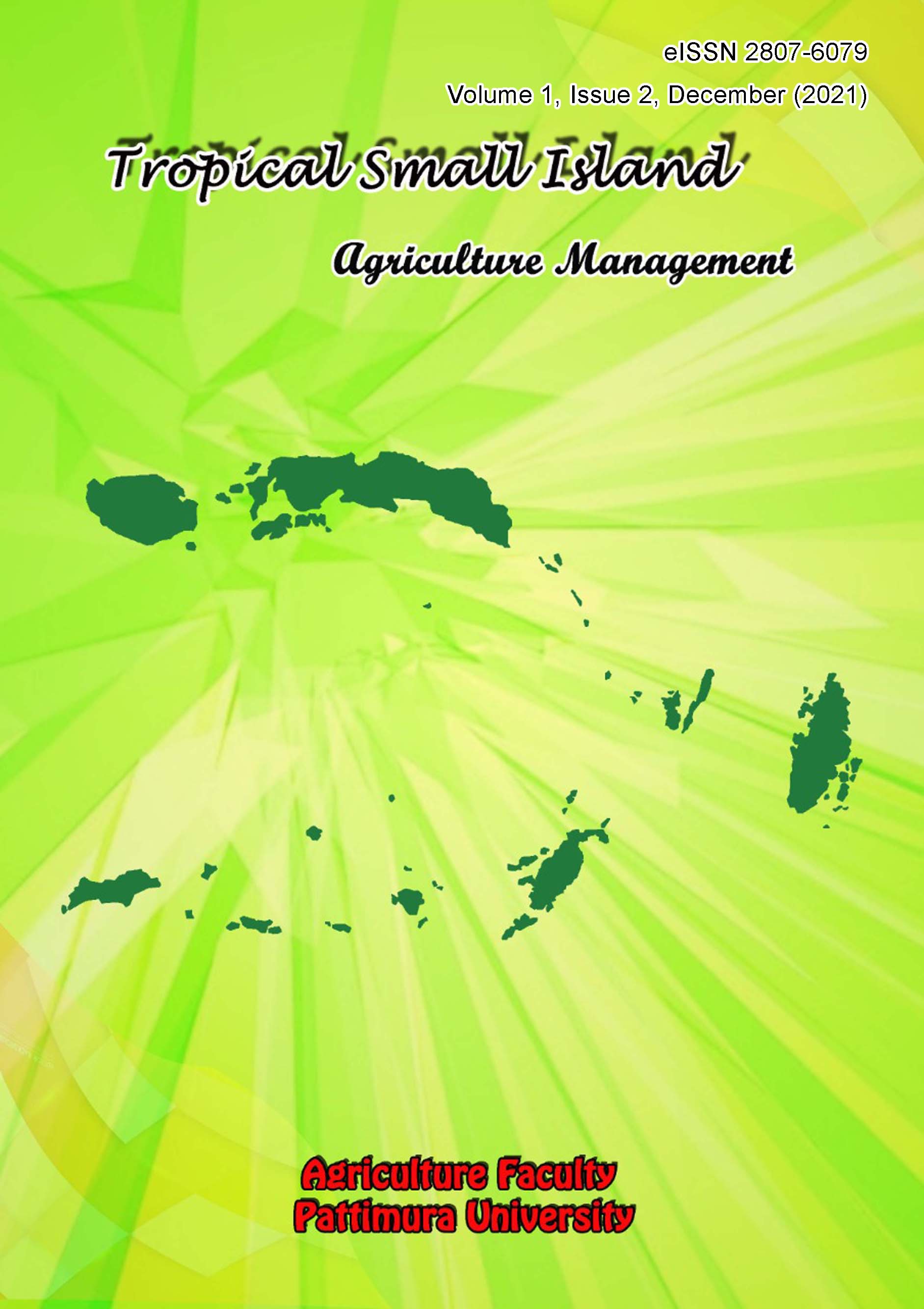Production and Marketing of Kolang-Kaling as a Derivative Product of Palm Fruit (Arenga pinnata) in Toisapu Hamlet, Negeri Hutumuri Ambon City
Abstract
This study aimed to determine the process of processing enau into kolang-kaling and analyze the income of processing enau into kolang-kaling. The research area was defined in Dusun Toisapu, Negeri Hutumuri. The research sampling used the interview method, with a research sample of 15 members of the social forestry business group. The results showed that the stages of processing enau into kolang-kaling consisted of six stages: preparation of raw materials, separation of palm fruit, boiling, cooling, peeling, and soaking—the KUPS. Aren kolang-kaling business income analysis in April-September 2023 amounted to IDR 1.178.118 for six months of production of 168 kg, which is profitable because the ratio of total costs is IDR. 3.861.882 incurred is smaller than the total cost of revenue received IDR 5.040.000. The business can provide returns in the form of more significant income for the KUPS kolang-kaling marketing system, from producers to consumers.
Downloads
References
Arief, A. (2001). Hutan dan Kehutanan. Kanisius.
Arif Maulana Rahman, Markum, M., & Setiawan, B. (2024). Diversifikasi Produk, Nilai Tambah, dan Pemasaran Aren Di Hkm Giri Madia Kabupaten Lombok Barat. Wahana Forestra: Jurnal Kehutanan, 19(1). https://doi.org/10.31849/forestra.v19i1.11890
Aryanti, M., Soleh, M. A., & Yudithia, M. (2017). Respon pertumbuhan tanaman aren (Arenga pinnata Merr.) dengan pemberian pupuk organik berbeda dosis. Jurnal Kultivasi, 16(1), 271–278.
Baharuddin, & Taskirawati, I. (2009). Buku Ajar Hasil Hutan Bukan Kayu. Fakultas Kehutanan Universitas Hasanuddin.
Baqiroh, N. F. A. B. (2019). Menakar Potensi Hasil Hutan Bukan Kayu. Bisnis.Com.
García Reyes, L. E. (2013). Analisis Kebijakan Produksi, Pemasaran dan Pengolahan Kayu dan HHBK di Sumbawa NTB. Journal of Chemical Information and Modeling, 53(9).
Pepadu, J., Suciati, N. N. P., Maulana, M. A., Royani, V. A., Yusnevia, M., Ramdhani, R. P., Azhari, R., Azizah, N., Notonegoro, R., Yanti, A. O., Yuliatna, R. D., & Hiden, H. (2023). Inovasi pemanfaatan kolang-kaling desa gelangsar menjadi kerupuk bernilai jual tinggi. Jurnal Pepadu, 3(4). https://doi.org/10.29303/pepadu.v3i4.2462
Rahardjo, M. (2017). Studi Kasus Dalam Penelitian Kualitatif: Konsep dan Prosedur. Universitas Islam Negeri Maulana Malik Ibrahim Malang Program Pascasarjana.
Salaka, F.J., Nugroho, B., & Nurrochmat, D.R. (2012). Marketing Policy Strategy for Non Timber Forest Products in West Seram Regency, Maluku Province. Jurnal Analisis Kebijakan Kehutanan, 9(1).
Santoso, A., Wibisono, Y., & Djamali, R. A. (2019). Peningkatan Nilai Tambah Produk Kolang-kaling Masyarakat Desa Wonoasri Kawasan Taman Nasional Merubetiri. Seminar Nasional Hasil Pengabdian Masyarakat Dan Penelitian Pranata Laboratoritum Pendidikan Politektik Negeri Jember Tahun 2019.
Simatupang, U. C. J., Sinaga, A. H., & Gea, B. J. P. (2023). Study nilai tambah air nira menjadi gula merah di Desa Buluh Awar, Kecamatan Sibolangit, Kabupaten Deli Serdang. Jurnal Darma Agung, 31(3). https://doi.org/10.46930/ojsuda.v31i3.3410
Sofjan., A. (2014). Manajemen Pemasaran. Raja Grafindo Persada.
Tarmizi, A. (2018). Strategi pemasaran UMKM. Jurnal Riset Manajemen Dan Bisnis (JRMB), 3(2), 191–198. https://doi.org/10.36226/jrmb.v3i2.107
Trihastuti, A. E. (2021). Manajemen Pemasaran Plus++. Deepublish.
Widarawati, R., Yudono, P., Indradwa, D., & Utami, S. N. H. (2016). Profil Budidaya Aren (Arenga pinnata (Wurmb.) Merr) Pada Berbagai Ketinggian Tempat Di Wilayah Samigaluh Kabupaten Kulonprogo. Prosiding Seminar Nasional Pengembangan Potensi Sumberdaya Lokal Berwawasan Lingkungan Untuk Penguatan Produk Pertanian Nasional Berdaya Saing Global.
Wulantika, T. (2020). Potensi Produksi Nira Enau (Arenga pinnata Merr) di Kec. Bukik Barisan Kabupaten Limapuluh Kota. SINTA Journal, 1(1). https://doi.org/10.37638/sinta.1.1.1-6
Copyright (c) 2024 The Author(s)

This work is licensed under a Creative Commons Attribution-ShareAlike 4.0 International License.
Authors who publish with this journal agree to the following terms:
- Authors retain copyright and grant the journal right of first publication with the work simultaneously licensed under a Creative Commons Attribution License that allows others to share the work with an acknowledgment of the work's authorship and initial publication in this journal.
- Authors are able to enter into separate, additional contractual arrangements for the non-exclusive distribution of the journal's published version of the work (e.g., post it to an institutional repository or publish it in a book), with an acknowledgment of its initial publication in this journal.
- Authors are permitted and encouraged to post their work online (e.g., in institutional repositories or on their website) prior to and during the submission process, as it can lead to productive exchanges, as well as earlier and greater citation of published work (See The Effect of Open Access).









